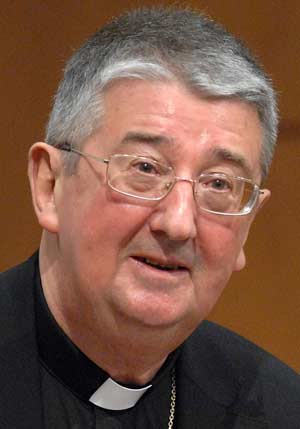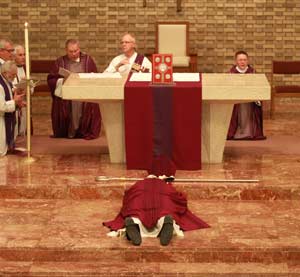 Archbishop Diarmuid MartinMILWAUKEE — “The Archdiocese of Dublin got it spectacularly wrong. Not ‘spectacularly wrong, but …’ Spectacularly wrong – full stop,” said Archbishop Diarmuid Martin of Dublin.
Archbishop Diarmuid MartinMILWAUKEE — “The Archdiocese of Dublin got it spectacularly wrong. Not ‘spectacularly wrong, but …’ Spectacularly wrong – full stop,” said Archbishop Diarmuid Martin of Dublin.
He made the comments during “Harm, Hope and Healing: International Dialogue on the Clergy Sex Abuse Scandal,” a two-day restorative justice themed conference, hosted by Marquette University’s Law School, to discuss the church’s sexual abuse scandal. Archbishop Martin was one of several Irish participants.
After serving as a Vatican diplomat to the United Nations, Archbishop Martin was reassigned to his homeland during Dublin’s clergy abuse scandal.
“I remember well the first complaint which arrived on my desk. At the top of the file – I remember this very well – there was a yellow page, saying ‘Inspected regarding child abuse, nothing found,’” he said in his presentation on the first day of the conference, April 4. “I looked in the priest’s file (for) earlier indications.
The next document – an internal note: ‘Father X seems to be back to his old activities.’ “
“Clearly there was knowledge of his old activities, but no acknowledgment that these activities raised red flags,” he said.
While civil authorities were informed and the priest was permanently removed from ministry, Archbishop Martin said he “cannot accept a situation where no one need assume responsibility in the face of terrible damage done to children in the church of Jesus Christ in Dublin.”
He said the responses seemed to blame others or that it was the fault of the diocesan administration system.
“The explosion of abuse cases occurs in the 1970s, and early ‘80s. The question has to be asked – what was going on in the seminaries?” he asked. “Certainly there was a culture which thought that mercy would heal offenders. I believe that there was a false understanding of human nature, and also of mercy. Serial abusers weaved their way in and out of the net of mercy for years. What was really needed was that they be firmly blocked on their path.”
Between 1940 and 2010 allegations were raised concerning 90 diocesan and 60 religious priests in the Dublin Archdiocese, he said. Ten Dublin priests and two non-diocesan priests were convicted, he added.
 As a gesture of repentance, Archbishop Jerome E. Listecki lies prostrate before the altar during the Mass of Atonement held Thursday, April 7 at St. Matthias Parish, Milwaukee. The Mass, held during Safe Environment Week, is a step in the archdiocese’s journey of acknowledging past sexual abuse by clergy and “moving forward to a better future,” according to the archdiocesan website. (Catholic Herald photo by Allen Fredrickson) The recognized number of victims is 570, but it’s generally accepted “that it must run into the thousands,” he said, “particularly by 10 priests who were clearly, classical serial pedophiles. Some had been abusing from the time they were in the seminary” leaving behind them a decades-long “trail of disaster.”
As a gesture of repentance, Archbishop Jerome E. Listecki lies prostrate before the altar during the Mass of Atonement held Thursday, April 7 at St. Matthias Parish, Milwaukee. The Mass, held during Safe Environment Week, is a step in the archdiocese’s journey of acknowledging past sexual abuse by clergy and “moving forward to a better future,” according to the archdiocesan website. (Catholic Herald photo by Allen Fredrickson) The recognized number of victims is 570, but it’s generally accepted “that it must run into the thousands,” he said, “particularly by 10 priests who were clearly, classical serial pedophiles. Some had been abusing from the time they were in the seminary” leaving behind them a decades-long “trail of disaster.”
“If Father X admitted to 100 victims, there are valid indications that he abused hundreds more,” he said. “The number of family members then easily reaches into the thousands. That’s just for one priest. Multiply it by 10 serial pedophiles. We have no accurate statistics about those who took their own lives.”
The circumstances surrounding cases border on the outlandish, and point to collusion among fellow clergy, he said.
In more than one case, “children were abused by one priest, while there was another living upstairs,” he said. One priest “was causing concern because he had his car so full of children, that another priest said, ‘Maybe one will fall out and get hurt.’ There were appalling instances in the schools for the deaf and blind. Too often it was the most vulnerable” who suffered most, he said.
“In Dublin, one priest built a private swimming pool in his backyard, where only children of a certain age and appearance were invited,” said Archbishop Martin. “He was in one school each morning, and in the other in the afternoon. That man abused for years.”
“There were eight other priests in that parish. Did no one notice? More than one survivor told me they were jeered by other children for being in contact with abuser priests. The children on the streets knew, but those in authority were blind,” he said.
“One victim survivor reminded me about Jesus’ gripping words in Matthew 18:6 – the great millstone to be fastened around the neck of anyone who becomes a stumbling block for the little ones,” he said. “Those words are quickly followed (Mt 18:12) by the teaching on the shepherd who leaves the 99 sheep to find the one lost. That to me is the lost child, the molested child. The church should actively seek out victims, to grace them with the healing power of Jesus Christ.”
Archbishop Martin, who became archbishop of Dublin in 2004, had experience with abuse through his work with the UN council on refugees.
His predecessor, Cardinal Desmond Connell, had put in place the first norms, a diocesan panel and a diocesan child protection office with a lay director.
Yet, “that first case led me to serious misgivings about earlier examinations,” he said. “That yellow page, I was told, was a very brief summary carried out rather rapidly over the previous Christmas holiday by three priests.”
His first decision was to have all files re-examined by an independent outside expert. The newly developed (National Board for Safeguarding Children in the Catholic Church) needed “access to all files, on all levels, on an ongoing basis – done by competent professionals,” he said. “Not three priests over Christmas. I re-established use of canonical trials for abusers. I agree they take far too long, and sometimes never finish. But the situation where nothing was done was far worse.”
“There was a culture where the church dealt with their own things in their own way,” he said. “We had this mixture – avoid scandal at all costs, but also, be merciful. ‘Poor Father, he really was very good.’”
When the archbishop confronted priests, he was shocked by their denial and unrepentant nature.
“Some would only admit when you ‘showed them the movie,’ as I say. They say, ‘No, it never happened.’ You build a case, say, ‘He gives a perfect description of your room, your behavior, everything.’ Then he says, ‘Well, I think that something did happen there, but it wasn’t as bad as he says.’”
“Then you get another movie, and well you can guess what happened,” he said. “But how many movies are there? They were living in a world where they covered themselves and covered themselves and covered their back and any recognition of guilt – they felt that whole wall would fall.”
About the same time, the Irish government established its own investigative body – The Murphy Commission.
“It had the power to request any documentation regarding any priest against whom allegations had been made, or about whom suspicions existed. They had serious powers to enforce that,” he said.
Archbishop Martin said he also widened his own investigation and discovered that files were being located in the most unlikely places in up to 10 diocesan offices or with auxiliary bishops or retired officials.
“My requests went at times unanswered, even after repeated requests,” he said. “In one case, I saw documents for the first time only when shown them by the government commission to comment on them. This dispersal of information, and lack of communication between officials, authorities and branches of the church contributed significantly” to the scandal.
The archbishop described his situation as difficult during the commission’s investigation.
“I could not speak about the evidence that was unfolding. Priests were suspicious, feeling I was allowing uncontrolled access to their personal information. All institutions protect themselves and are opposed to airing of their dirty laundry,” he said.
“Yet, the commission said the record keeping was superb. We had a magnificent archive of criminal behavior,” he said. “The commission would never have been able to deliver anything, except for the 70,000 documents I gave them.”
As he learned more and met with victims, parents, spouses and children, the archbishop became more convinced he was doing the right thing.
“With all my personal failings, when I arrive to St. Peter, he’ll weigh my case against the 70,000 documents on the other side of the scale,” he said.
As the Dublin Archdiocese received more and more complaints about pedophile priests, Archbishop Martin said some people recommended a legal challenge.
“There were even those who claimed I should challenge Judge (Yvonne) Murphy herself,” he said. “No report could be without defects. But in its essence, it illustrated a reality which can only be described as horrendous. What did it say to people that it happened within the church of Jesus Christ?”
In response, “the archdiocese organized a liturgy of lament and repentance; prepared primarily by victims,” the archbishop said. “There was risk that a public event could be derailed. Last Easter people entered my cathedral and littered the altar with children’s shoes.”
“The liturgy turned out to be truly restorative,” he said. “It was not presided over by any cardinal or archbishop. By design, the entire sanctuary was empty except for one large, stark wooden cross. Anyone who spoke came out of, and returned to, their place among the people of God.”
After seven years as archbishop, Archbishop Martin admits mistakes were made.
“It was thought best to handle allegations within (the church’s) own structures and to use secrecy to avoid scandal. The church treated those who came forward as somehow adding to the problem. Some were never given the impression they were even believed. Priests who’ve dedicated their entire lives to ministry and witness feel damaged and wounded by the sinful acts of others,” he said.
“A lot has changed. Today the church in Ireland is much safer,” he said. “We have only found one priest abusing this century. But I don’t trumpet that too loud, since he was abusing under my watch and I did not know. And most victims come forward 20 years later. How do I know that there aren’t people with a terrible secret in their heart today? And what would I be saying to them?”
“A restorative justice approach can create a new culture within the Catholic Church,” he said. “But the care of each of the most vulnerable and wounded (must) truly become the dominant concern of the 99 others.”
